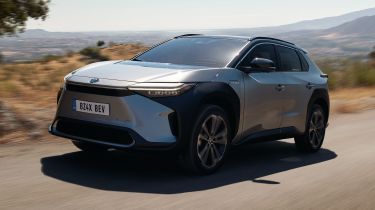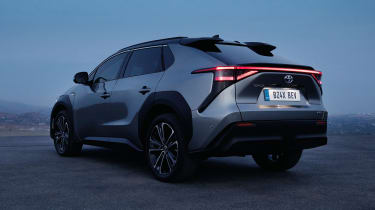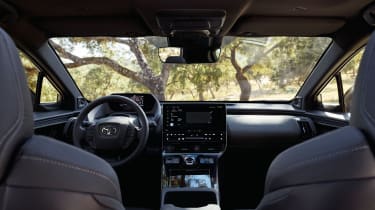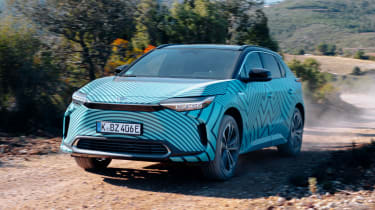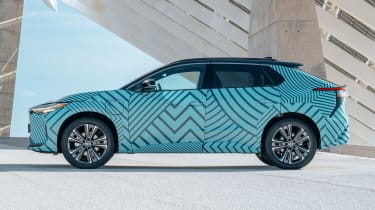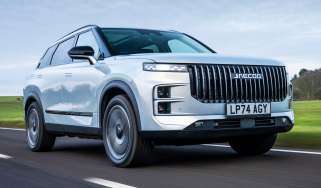New Toyota bZ4X electric SUV: prices, specs, release date and prototype drive
Toyota RAV4-sized electric SUV manages up to 317 miles of range, with prices from £41,950
- A bold exterior design and minimalist interior
- Prices from £41,950, with first cars due in June
- New car forms part of a wider range of ‘bZ’ models
The new Toyota bZ4X will manage up to 317 miles from a full charge, which means the Japanes firm’s first electric SUV will be competitive with rivals.
The WLTP-rated range of 317 miles is for the front-wheel-drive model, which packs a fairly large 71.4kWh battery. That drops to 285 miles for the all-wheel-drive version. Respectively, the front- and all-wheel-drive models have efficiency figures of 4.3 miles/kW and 3.9 miles/kW.
 Top 10 best electric SUVs – the ones to buy in 2025
Top 10 best electric SUVs – the ones to buy in 2025
In comparison, the Skoda Enyaq manages more than 320 miles with a slightly bigger, 77kWh battery, while the similarly sized battery in the Kia EV6 returns a few miles more. It seems unlikely that Toyota will offer the smaller battery option you can choose on the Enyaq or Volkswagen ID.4.
It’ll be similar in size to a Toyota RAV4, with prices starting from £41,950. The first customer cars will arrive in the UK in June 2022, with the bZ4X being the first of five new bZ-branded electric models to launch in Europe by 2025.
To see how the new model is shaping up, we’ve already driven a prototype of the bZ4X, and we can report it left us with a positive impression. Read on for our full lowdown on the new Toyota bZ4X and prototype review.
2022 Toyota bZX4 SUV: trims, specifications and pricing
The Toyota bZX4 will launch with four trim levels: Pure, Motion, Vision and Premiere Edition, as well as a choice of front or X-Mode all-wheel drive. The Premiere Edition is expected to be on sale for a limited time only.
Pure models get 18-inch wheels, an eight-inch touchscreen infotainment system, plus a seven-inch digital instrument cluster. Keyless entry and remote connectivity is also standard – the latter allowing owners to preheat or pre-cool the car from their smartphones. This tech should also give customers remote access to range and charging information. The Pure specification is only available in front-wheel-drive guise.
Motion starts from £45,750 and brings the option of X-Mode four-wheel drive for an additional £2,600. These cars get an electric tailgate and privacy glass, plus a rear spoiler and parking sensors. Inside, there are heated seats, ambient lighting and wireless phone charging. Going for the Motion model also opens up a larger list of options.
The last of the core trim choices is the bZ4X Vision, from £47,650. Opting for this trim adds 20-inch wheels, heated and ventilated synthetic leather seats, and a heated steering wheel. It also comes with a digital key, which Toyota says can provide access to others via a smartphone app. Like the Motion, the Vision is available with either front or all-wheel drive.
The Premiere Edition tops the bZ4X range for the time being, starting from £51,550. It brings luxuries such as a nine-speaker JBL stereo and a panoramic roof. This version is available exclusively through Toyota’s online retail service and comes as standard with X-Mode all-wheel drive; there’s no front-wheel drive Premiere Edition.
Toyota had previously focused on hybrid technology and hydrogen fuel cells but is now ready to produce its own fully electric cars under the ‘bZ’ (for ‘beyond Zero’) sub-brand. The bZ4X is developed with help from Subaru; the Subaru Solterra will also go on sale in the UK soon.
Toyota revealed a bZ4X ‘concept’ a while ago and the production version is almost identical, other than a proper steering wheel in place of an aircraft-style yoke. Compared to the Toyota RAV4, the bZ4X is 85mm lower and the wheelbase (the distance between front and rear wheels) is 160mm longer - freeing up lots of space inside. Toyota has already revealed that the legroom in the bZ4X Concept is similar to that of the Lexus LS saloon.
Sitting on a new e-TNGA platform, the all-electric version of the modular platform that has underpinned all recent Toyota models, the bZ4X will be a direct rival to the Skoda Enyaq, the Nissan Ariya and the Volkswagen ID.4.
Exterior and design
Keeping tradition with hybrid-powered Toyotas, the bZ4X concept features a bold exterior look with plenty of sharp, angular lines, and a cab-rearward design, which gives the SUV a notably long bonnet. Since the bZ4X is fully electric, a conventional grille has been replaced with a small ‘mouth’ just beneath the bonnet.
Ultra-slim daytime running lights sit above quadruple-lens headlights, while a light bar runs right across the rear, above louvred-effect tail-lights. A contrast of materials, including gloss-black plastics that line the wheel arches, complete the look.
From a more functional perspective, Toyota says the bZ4X incorporates a roof-mounted solar panel to help charge the battery.
Interior and technology
Inside, the bZ4X is pleasingly simple. The cabin features a small instrument panel and a neatly integrated widescreen infotainment system, with the use of fabric on the main fascia. We’re glad to see a proper steering wheel, rather than the odd device found in the concept, and the instrument cluster has been designed to sit above the steering wheel in the driver’s eyeline. The ‘One Motion Grip-control’ yoke fitted in the concept may come to Europe at a later date.
With the five seats in place, there’s a 452-litre boot. It’s noticeably smaller than the 580 litres you get in the hybrid RAV4 but passenger space should be much more generous in the bZ4X. Luggage capacity is still a reasonable size for a family SUV, if far from class-leading.
Range and performance
The new Toyota bZ4X uses a 71.4kWh battery pack with an estimated range of 280 miles. Toyota is aiming for an achievable figure, rather than a figure that’s better on paper than its rivals but hard to replicate in the real world. Plug in to a 150kW fast-charger and you’ll be able to top up to 80% capacity in under half an hour.
Front-wheel-drive and all-wheel-drive models will be available, with 201bhp and 215bhp respectively. The car can get from 0-62mph in 7.5 seconds in front-wheel drive form - a bit quicker than a Skoda Enyaq - and 6.9 seconds in more powerful all-wheel-drive guise. Like rivals, the bZ4X is fitted with regenerative braking to channel energy back to the battery, along with adjustable modes so drivers can change its strength on the fly.
Toyota claims that the battery will suffer far less degradation than other electric cars, charging to 90% capacity even after 10 years or 150,000 miles. Each individual cell is monitored constantly by the car’s computer, while the battery is water-cooled. An optional heat pump will help the car lose less range in cold conditions.
Subaru helped develop the four-wheel-drive system, which is said to make the car very capable off-road. There’s a mode for snow and mud, as well as a ‘deep snow’ mode that’s restricted to 13mph and a Grip Control setting for when the going gets really tough and you’re crawling at less than 6mph.
What can buyers expect?
The ‘bZ’ part of the car’s name stands for Beyond Zero, Toyota’s vision of carbon-neutral motoring, while the ‘X’ denotes a crossover body style. Toyota has trademarked a range of ‘bZ’ nameplates, and in many cases it has also registered the ‘X’ variant, so expect a whole series of electric models. The brand has already teased a whole load of new models, confirming that this platform will facilitate a whole range of different-sized cars, and will allow either two or four-wheel drive.
Toyota bZ4X prototype drive by Sean Carson
The Toyota bZ4X is a big deal for the Japanese brand, as after decades of leading the way in hybrid engine development, this new SUV is the brand's first pure-electric model since the US-only RAV4 EV ended production nearly two decades ago. Despite the bZ4X’s seemingly late arrival to the market, Toyota says that it’s launching the right model at the right time.
On paper at least, this claim seems to hold up: with the bZ4X promising a range of up to 280 miles, and a choice of both two- and four-wheel drive models - putting the model on a par with nearly all of its electrified competitors.
Our test car was the 215bhp all-wheel drive variant, and is what Toyota calls a late-stage prototype. Meaning that it’s not that far off what you’ll see in showrooms later this year. On the move the bZ4X doesn’t feel as quick as some four-wheel drive EVs, showing only respectable pace up to 70mph rather than startling acceleration. But the overall driving experience is very refined and hushed, with a strong level of refinement, barring some high-pitched wind noise from around the doors - something that should be eradicated when the car makes production.
Despite sitting on 20-inch alloy wheels, the bZX4 rode very well on our test route, which included a mixture of broken Spanish road surfaces and some light off-roading on gravel tracks, with the suspension doing an excellent job of soaking up the imperfections.
Its refinement doesn’t hinder handling either, as despite weighing in at over 2,000kg, the bZX4 remains composed in corners with minimal body lean. The steering also provides a positive amount of feel and feedback too. However, the regenerative braking system is not really capable of one-pedal driving even in its highest setting, a feature that is fast becoming essential in modern EVs.
Inside, some of the interior materials feel a little plasticky, although this is likely to be rectified before the model lands in showrooms. The interior feels a little staid in design, and the amount of storage cubbies on offer is respectable at best rather than groundbreaking, with a large central area between the front seats instead of a traditional glove box. There’s no ‘frunk’ in the nose either, meaning the charging cable will have to be stored in the boot, which is a decent enough size.
The most positive aspect of the interior is the new 12-inch infotainment touchscreen. While Toyota has previously lagged behind rivals in this area, this new system is a huge step forward for the brand with sharp graphics and swift and snappy responses. It also features the latest in smartphone connectivity, which is a welcome addition.
The digital dial cluster is less impressive though, falling short of rivals for clarity. Standard equipment is plentiful as well, along with an impressive array of safety features including AEB with collision warning and cross traffic alert, which operates via a camera and radar assembly hidden in the black trim piece mounted between the headlights.
Interior space is good along with decent visibility. Rear room is also good, but the bZ4X is far from the roomiest model in its class.
The success of the Toyota bZX4 will depend on the monthly cost for most buyers, with the brand focusing on lease deals, which costs £611 a month over three years including free servicing after a £3,662 initial rental. Opt for a PCP deal, and you're looking at £670 per month with a deposit of £3,662 and £12 a month extra for servicing.
Verdict:
Our early drive of the new Toyota bZ4X shows it’s a competent entry into the electric SUV market. Its claimed range figures should be achievable, and while it doesn’t really stretch the boundaries of what’s possible in any overall area, it does boast an excellent blend of practicality, smartly integrated technology and a positively refined driving experience that should be easy to live with.
Read our guides to the best electric cars and the best cars coming out in 2022 and beyond.
Recommended

New Subaru Trailseeker revealed as rugged electric SUV with 375bhp

New Subaru Solterra brings more range, power and polish
Most Popular

Suzuki’s new 10-year warranty is free – here’s how to get it
Tips & advice

Car dashboard warning lights: what does each symbol mean?

Electric car charging stations: public networks, charger types, apps and maps


